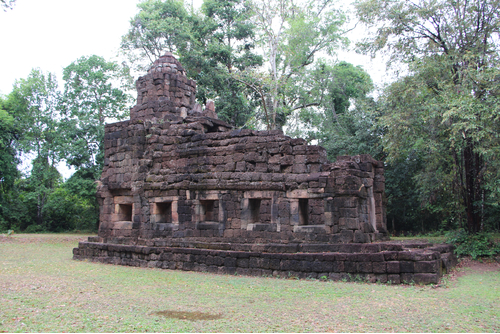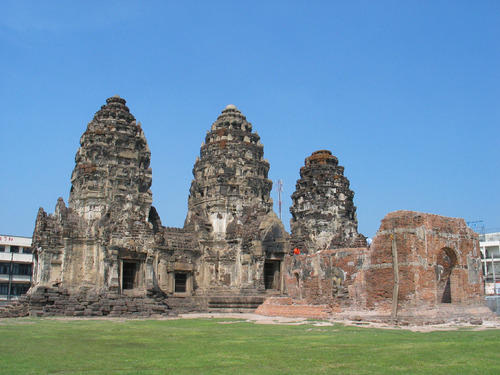ค้นหางานศิลปกรรม
ฐานข้อมูลศิลปกรรมในเอเชียตะวันออกเฉียงใต้
สถาปัตยกรรมปราสาทตาเมือน
รูปแบบแผนผังของปราสาทตาเมือน เป็นลักษณะของโบราณสถานที่เรียกว่า “ธรรมศาลา หรือ ที่พักคนเดินทาง” ซึ่งในสมัยพระเจ้าชัยวรมันที่ 7 ราวพุทธศตวรรษที่ 18 โปรดให้สร้างขึ้นตามเส้นทางที่สำคัญทั่วราชอาณาจักร ธรรมศาลานี้มีลักษณะเป็นปราสาทหลังเดียว ก่อสร้างด้วยศิลาแลงและหินทราย แผนผังเป็นรูปสี่เหลี่ยมจัตุรัสย่อมุม ด้านหน้าของปราสาททำเป็นห้องยาวสร้างด้วยศิลาแลง มีประตูเชื่อมต่อกับองค์ปราสาททางด้านทิศตะวันตก ห้องยาวนี้มีผนังด้านหนึ่งเจาะเป็นช่องหน้าต่างเรียงกันเป็นแถว ส่วนผนังอีกด้านหนึ่งทำเป็นหน้าต่างหลอก ด้านหน้าทางทิศตะวันออกมีประตูทางเข้าออก 1 ประตู มีทับหลังหินทรายสลักภาพพระพุทธรูปปางสมาธิในซุ้มเรือนแก้ว
สถาปัตยกรรมปรางค์สามยอด
พระปรางค์สามยอดเป็นปราสาทในวัฒนธรรมเขมรที่ใช้ศิลาแลงเป็นวัสดุหลัก มีหินทรายก่อเป็นหน้าบันและองค์ประกอบอื่นๆ อิฐสมัยกรุงศรีอยุธยานำมาก่อปิดช่องหน้าต่าง ปูนปั้นประดับหลุดล่วงเป็นส่วนใหญ่อาคารประธานเป็นปราสาทสามหลังเรียงตัวกันตามแนวเหนือ-ใต้ หันหน้าไปทางทิศตะวันออก แต่ละองค์เชื่อมต่อกันโดยฉนวน ทั้งสามหลังมีองค์ประกอบแบบเดียวกัน เพียงแต่องค์กลางสูงใหญ่กว่าเล็กน้อย แผนผังเพิ่มมุม ออกมุขที่ด้านทั้งสี่ ภายในปราสาทแต่ละหลังมีแท่นฐานประดิษฐานรูปเคารพ แต่รูปเคารพเดิมเคลื่อนย้ายหมดแล้ว หลังคาชั้นซ้อนลดหลั่นกัน 5 ชั้น ต่อด้วยบัวกลุ่ม นภศูลหักหายไปแล้ว ด้านหน้าปราสาทองค์กลางมีวิหารก่ออิฐแผนผังสี่เหลี่ยมผืนผ้า ภายในประดิษฐานพระพุทธรูปนั่ง ก่อประตูเป็นวงโค้ง



